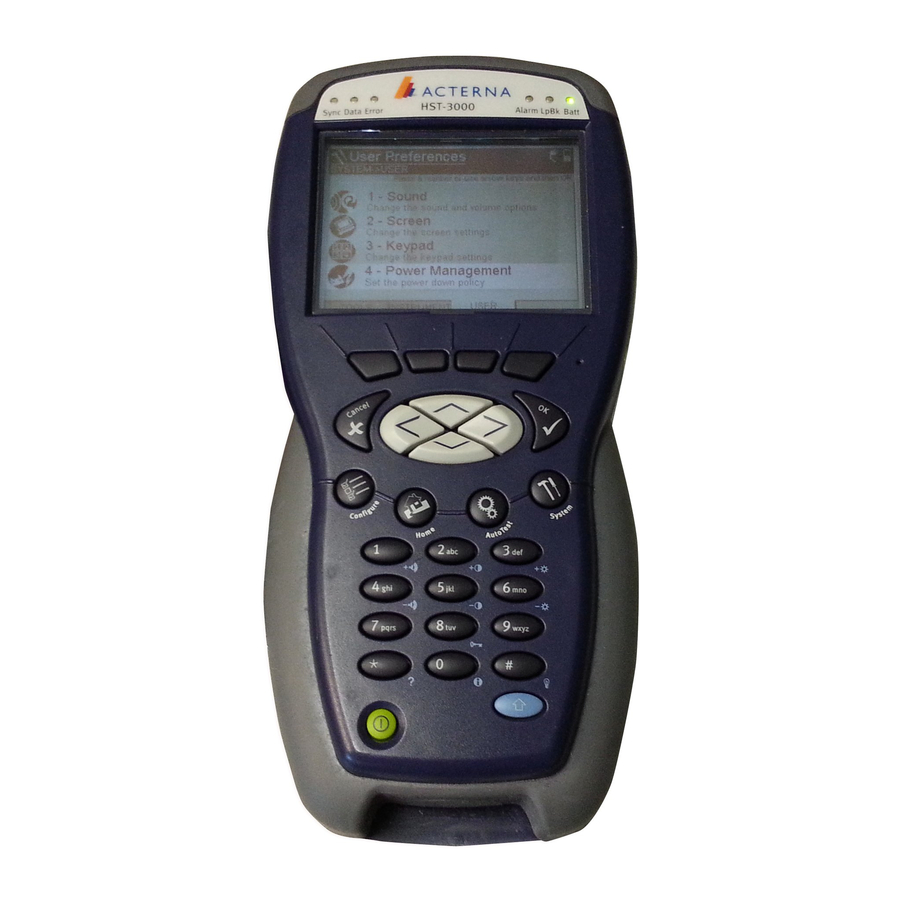
JDS Uniphase HST-3000 Instruction Manual
Vdsl quick card
Hide thumbs
Also See for HST-3000:
- User manual (356 pages) ,
- Testing manual (24 pages) ,
- Product manual (8 pages)
Summary of Contents for JDS Uniphase HST-3000
- Page 1 HST-3000 VDSL QUICK CARD Revision 9.0 Technical Assistance: 1-866-228-3762 TAC@jdsu.com March 2012 © 2012 JDSU. All rights reserved.
- Page 2 DSTF (distance strap to fault). Th e RFL test performed with the HST-3000 (CAT 500 H/W) When using an HST-3000 for an RFL test, the terms tip, ring, and ground are not used. Instead, the connec- tions are as follows: Unfaulted or “Good”...
- Page 3 V D S L 2 Q U I C K C A R D Resistive Fault Location (RFL) Test Two Methods for Performing an RFL Test Separate pair method (CAT 500 H/W) Th e separate pair method is preferred because it is the only method that can be used for a double-sided fault (both wires in a pair are faulted).
- Page 4 RFL testing takes approximately 30 to 40 seconds. Arrows indicating the paths that are being tested will be displayed on the HST-3000’s screen. Once the test is completed, each result will be shown in either ohms or feet.
- Page 5 It is possible to have more than one gauge of wire over the length of the cable. Th ere are diff erent methods for adjusting the temperature and gauge when performing RFL testing on multi-gauge and single gauge cable spans. Single-Gauge Cable Span: It is easy to adjust the temperature and gauge displayed on the HST-3000’s RFL Up Arrow Down testing screen.
- Page 6 V D S L 2 Q U I C K C A R D Resistive Fault Location (RFL) Test Two Methods for Performing an RFL Test RFL Test Single Pair Method (CAT 500 H/W) (continued) Multi-Gauge Cable Span: Technicians use the multi-gauge setup option to accurately measure a pair con- taining sections of multiple gauges and/or cable with diff erent temperatures (buried and aerial).
- Page 7 V D S L 2 Q U I C K C A R D Resistive Fault Location (RFL) Test CAT 510 Hardware: In eff orts for continuous improvement, the latest hardware circuit board (CAT 510) adds new RFL functions and features, outlined below. Green on Ground- Instead of connecting the Green lead to the GOOD wire, Green is connect to Ground for both single pair and separate good pair RFL.
- Page 8 Cat 510 Hardware K-Test Th e HST-3000 equipped with the CAT 510 copper board adds an additional RFL test feature called K (Kup- fmuller) Test. Th e K-Test highlights its to locate double sided cable faults when no “good pair” is available.
- Page 9 Cat 510 Hardware Using the K-Test 1. Using the HST-3000 Ohm meter, the technician identifi es two conductors which meet the above criteria for the K-Test. It is important to note these can be any two conductors in the cable provided they meet the ratio requirements listed above.
- Page 10 V D S L 2 Q U I C K C A R D RFL Test Cat 510 Hardware Using the K-Test (continued) 7. Th e HST will determine if the ratio between conductors is correct. If an invalid ratio is present the HST will abort the K-Test. 8.
- Page 11 2. Select the appropriate mode (Single Pair Manual Strap or Separate Pair Manual Strap) and press OK. Conf gure 3. Press the navigation key. 4. Follow the instructions on the screen and connect the HST-3000 test leads to the test cable Compensate 5. Press the soft key 6.
- Page 12 -- small amounts of leakage that occur even over a good wire. More of this leakage is present over longer distances. Th erefore, to keep DTS as short as possible, technicians can sectionalize the cable by using the HST-3000’s Ohmmeter to locate the section of cable that contains the fault, then stop and test just that section.
- Page 13 V D S L 2 Q U I C K C A R D RFL Test RFL Test Connections and Ohms (continued) Helpful Hints and Tips Ohms in Strap: It is important that the strap attached to the end of the wires under test has the least amount of resistance as possible to maintain the accuracy of the RFL.Th e greater the strap’s resistance, the more inac- curate the measurement.
- Page 14 V D S L 2 Q U I C K C A R D RFL Test RFL Test Connections and Ohms (continued) Warnings Multiple faults: RFL cannot accurately determine the location of multiple faults on a pair. Because distance is based on the assumption that resistance is caused by a single fault in one location, multiple faults cause errors in the resistance measurement, which, in turn, cause errors when converting resistance to a distance.













Need help?
Do you have a question about the HST-3000 and is the answer not in the manual?
Questions and answers